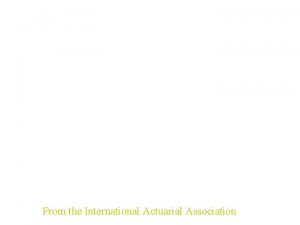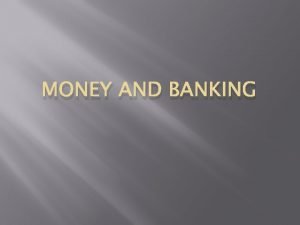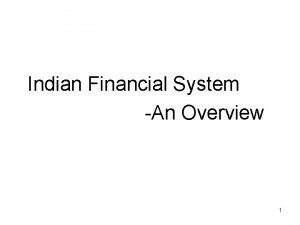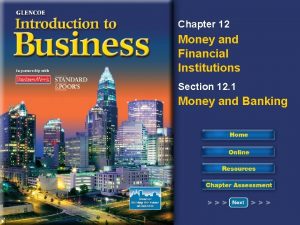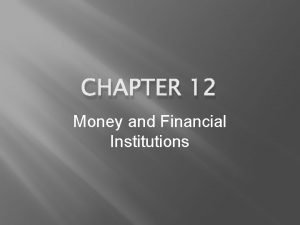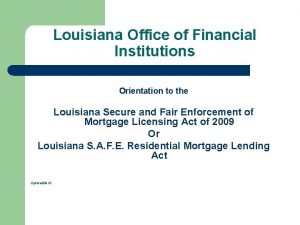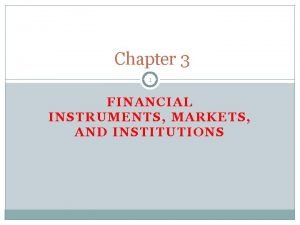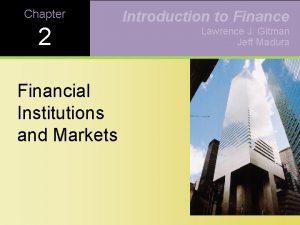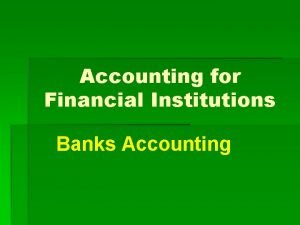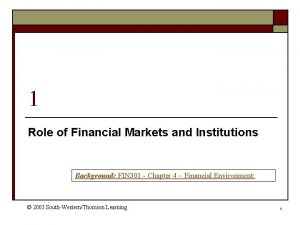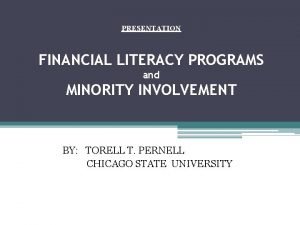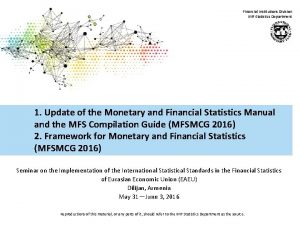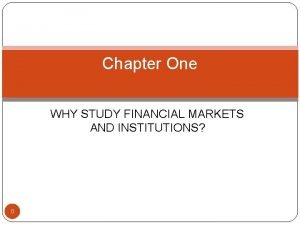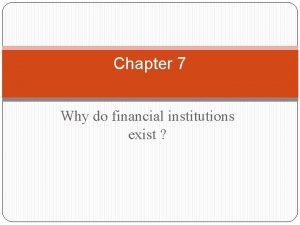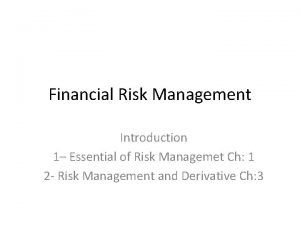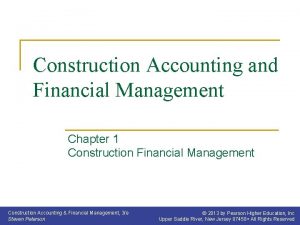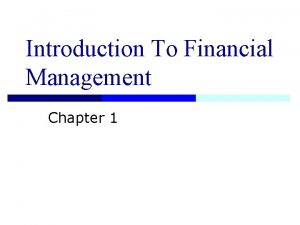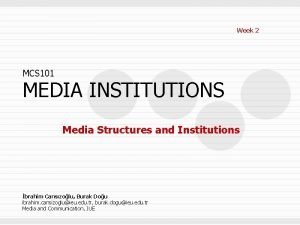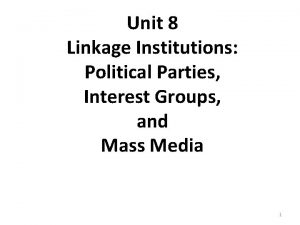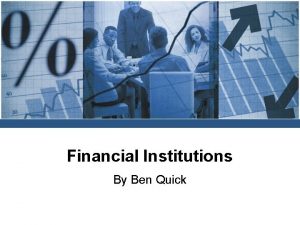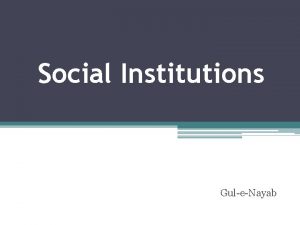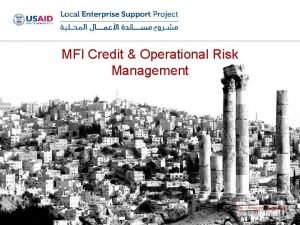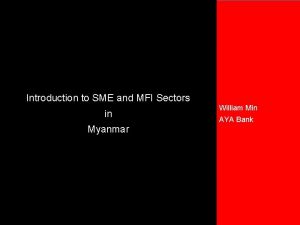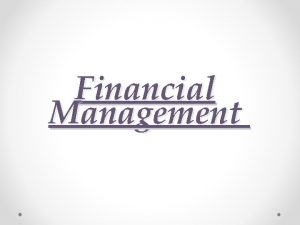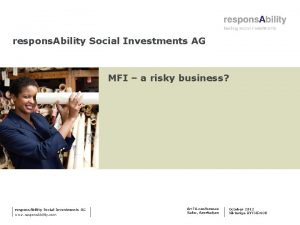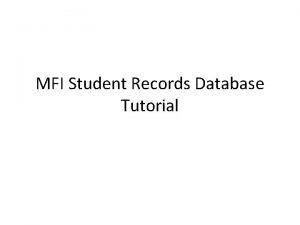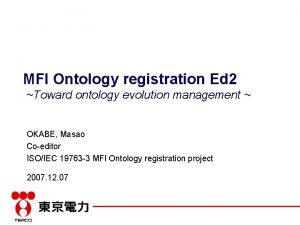MANAGEMENT OF FINANCIAL INSTITUTIONS MFI INTRODUCTION TO FINANCIAL






























- Slides: 30

MANAGEMENT OF FINANCIAL INSTITUTIONS (MFI) INTRODUCTION TO FINANCIAL INSTITUTIONS Course Teacher: MD. NURUL HOQUE MBA, DAIBB(IBB), , BCS(EDU) Deputy General Manager Sonali Bank Limited Guest Speaker of Dhaka University Part time teacher: EMBA(DU), BAFEDA, Stamford & East West university

MANAGEMENT OF FINANCIAL INSTITUTIONS (MFI) Financial System in Bangladesh: What is financial system? It is a set of institutional arrangement through which financial surplus in the economy are mobilized from surplus units and transferred to deficit units. What are the constituents of Financial System? Financial In our financial system there are three constituents, they are as follows: 1. Financial Institution 2. Financial Instruments 3. Financial Market

MANAGEMENT OF FINANCIAL INSTITUTIONS (MFI) Introduction to Business of Financial Institutions: Structure of Financial System of Bangladesh: q Financial Institutions/ Intermediaries q Financial Instruments q Financial Markets

MANAGEMENT OF FINANCIAL INSTITUTIONS (MFI) Regulators of Financial System: 1. MOF(APA)-Ministry of Finance 2. BB(MOU, CAMELS)-Central bank. 3. SEC-Security Exchange commission. 4. Acts-NI Act, AML Act, Artho Rin Act, Stamp Act etc. 5. Company Act- banking company act, sec act, Joint Stock co. and Insurance co. Banking Financial Institution: q Central Bank-Bangladesh bank. q Private Commercial Banks q Public Commercial Banks q Private Foreign Banks q Specialized Financial Institutions

Management of Financial Institutions (MFI) Non-Bank Financial Institution: q q q Insurance Companies Investments Banks Financial Companies ICB. Merchant banks. Investment company. Financial Instruments: 1. Money Market Instruments : * q q q q Loan & advance. Treasury bills Commercial Papers Letter of Credit Banker Acceptance Certificate of Deposit Re-purchase agreement(REPO) DD, MT, PO, Cheque etc.

Financial Instruments: 2. Capital Market Instruments: q. Bonds q. Stocks q. Govt. Securities q. Debenture q. Mortgage Financial Markets: q Primary Markets q Secondary markets q Money Markets q Capital Markets q Security & non-security markets

MANAGEMENT OF FINANCIAL INSTITUTIONS (MFI) Regulators of Financial System: 1. MOF (APA)-Ministry of Finance-BB, PCBs & PNBFIs. 2. BB(MOU, CAMELS)-Central bank: BFIs & NBFIs 3. SEC. : Security Exchange commission: Capital market Function of Central Bank and Commercial Banks in Bangladesh: Difference Between Banks and NBFIs. Problem of Financial Institutions Financial Statement Analysis:

Financial Statement Analysis: q q q q q Financial Spread Sheet Analysis Fund Flow and Cash Flow Analysis Liquidity Analysis Minimum/ Adequate Capital Core Risk Analysis Capital Budgeting Capital Rationing Assets Portfolio Financial Ratio Analysis Insurance System in Bangladesh: 1. General Insurancea. Marine, Air, Rail, Road, Multimodal. b. Fire insurance 2. Life Insurance.

FUNCTIONS OF BANGLADESH BANK* General function 1. Note issue 2. Monitoring of currency value 3. Control of money market. 4. Credit control. 5. Control of foreign exchange operation. * Function as Govt. Treasury bank 1. Custodian of govt. fund. 2. maintenance of govt. accounts. 3. Banker of other banks.

FUNCTIONS OF BB 4. Clearing house. 5. Loan monitoring, supervision & classification. 6. Audit of accounts. 7. Loan restructuring & rephrashment. 8. Economic research & development 9. Report & publication.

INTRODUCTION TO BUSINESS OF FIS. Function of BFIs and NBFIs. Role of banks in business. Money Role laundering preventions. of central bank. Commercial Financial Mobile bank & functions. statements analysis banking vs agent banking.

INTRODUCTION TO BUSINESS OF FIS. National strategy for prevention of money laundering & combating financing of terrorism. BFIU & its functions. Sources of fund of BFIs & NBFIs. Functions & quality of a manager. CRR & SRR.

MANAGEMENT OF FINANCIAL INSTITUTIONS (MFI) Different Types of Banking System: Unit Banking Single Office Small Local Area Small Capital Small Profit, No Any Branch Origin in USA Branch Banking Chain Banking Ownership (single or joint) So Many Bank in Similar Nature Same Nature in Business No Competition Within the Group Separate Authority & Board Separate Decision Origin in USA Group Banking Many Branches Control by Head Office. Maximum Share Purchase from Weak Bank by the Strong bank Local & foreign. Strong Bank Known as Holding Companies Large capital. Large profit. Origin in USA Separate Management Decision by the Central Board Result of Problem of Unit Banking Depository Banking Like Commercial Bank. Investment Banking Industrial Banking. Long Term Loan.

MANAGEMENT OF FINANCIAL INSTITUTIONS (MFI) Different Types of Banking System: Merchant Banking GSP financing company IDLC BIFC Lease Financing Underwriting of Share/Debenture Hire Purchase Advice for Amalgamation of Business Correspondent Banking Work as a Clearing House

Management of Financial Institutions (MFI) State Owned Commercial Bank (SOCB) There are 6 SOCB’s which are fully or majority owned by the Government of Bangladesh. After 1973, 2 Banks out of 6 SOCB converted to private bank. 1. Pubali Bank Limited and 2. Uttara Bank Limited. Now SOCB’s stands in four: 1. Sonali Bank Limited, 2. Janata Bank Limited, 3. Agrani Bank Limited, 4. Rupali Bank Limited. Specialized Bank (SDB’s) Four Specialized bank are now operating which were established for specific objectives like agricultural or industrial development. These banks are fully or majority owned by the Government of Bangladesh. These are 1. BDBL, 2. BASIC Bank limited 3. Bangladesh Krishi Bank, 4. Rajshahi Krishi Unnayan Bank.

Management of Financial Institutions (MFI) Private Commercial Bank (PCB) There are 40 private commercial banks which are majorly owned by the private entities. PCB’s can be Categorized into two groups: Conventional PCB’s: 32 Conventional PCB’s are now operating in the industry. They perform the banking functions in conventional fashion i. e. interest based operations. Islami Shariah based PCB’s: There are 8 Islami Shariah based PCB’s in Bangladesh and they execute banking activities according to Islami Shariah based principals i. e. profit-loss sharing (PLS) mode. Foreign Commercial Bank’s (FCB’s): 9 FCB’s are operating Bangladesh as in the branches of the banks which are incorporated in abroad. 1. City Bank N. A. 2. HSBC 3. Standard Chartered 4. Commercial bank of Ceylon 5. State bank of India 6. Habib Bank 7. National Bank of Pakistan 8. Bank Al-Falah.

MANAGEMENT OF FINANCIAL INSTITUTIONS (MFI) Non Scheduled banks: The banks, which are established for special and definite objective and opened under the Acts that are contacted for meeting up those objective are termed as nonscheduled banks. These Banks cannot performed all function of scheduled banks. There are 6 non-scheduled bank in Bangladesh which are 1. Ansar VDP Unnayan Bank, 2. Karmashangosthan Bank, 3. Grameen Bank, 4. Somobay Bank (Co-operative bank), 5. Probashi Kollyan Bank, 6. Palli Sanchay Bank.

MANAGEMENT OF FINANCIAL INSTITUTIONS (MFI) Non-banking Financial Institution : Non Bank Financial Institutions (FI’s) are those of financial institutions which are regulated under Financial Institution ACT, 1993 and under controlled by Bangladesh Bank. Now 33 FIs are operating in Bangladesh. Out of the total, 3 is fully government owned, rest was initiated by private domestic initiative and by joint venture initiative. Major Sources of funds of NBFIs are term deposit, credit facility from banks and other FIs, call money as well as bond and securitization. Main NBFIs areq Invest Corporation of Bangladesh (ICB) q Bangladesh House Building Finance Corporation (BHBFC) q Bank of Small Industry & Commerce (BSIC) q Industrial Development Leasing Company of Bangladesh (IDLC) q Saudia-Bangladesh Industrial and agriculture Investment Company Limited (SABINCO) q Industrial Promotion and Development Company Bangladesh (IPDCB) q United Leasing Company ( ULC)

Regulators of the Financial System: Central Bank (Regulator of money market) Bangladesh Bank acts as the Central Bank of Bangladesh which was established on December 16, 1971" through the enactment of Bangladesh Bank Order 1972 President's Order No. JT 7 of 7972 (Amended in 2003). The general superintendence and direction of the affairs and business of BB have been entrusted to a 9 members' Board of Directors which is headed by the Governor who is the Chief Executive Officer of this institution as well. BB has 45 departments and 10 branch offices. Regulator of Capital Market Intermediaries Securities and Exchange Commission (SEC) performs the functions to regulate the capital market intermediaries and issuance of capital and financial instruments by public limited companies. It was established on June 8, 1993 under the Securities and Exchange Commission Act, 1993. A 5 member commission headed by a Chairman has the overall responsibility to administer securities legislation and the Commission is attached to the Ministry of Finance. The mission of SEC is to protect the interests of securities investors, to develop and maintain fair, transparent and efficient securities markets and to ensure proper issuance of securities ancl compliance with securities laws. Regulator of Micro Finance Institutions To bring Non-government Microfinance Institutions (NGO - MFIs) under a regulatory framework, the Govemment of Bangladesh enacted "Microcredit Regulatory Authority Act, 2006' " (Act no. 32 of 2006) which came into effect from August 27, 20 A 6. Under this Act, the Govemment established Microcredit Regulatory Authority (MRA) with a view to ensuring transparency and aecountabilif of microcredit activities of the NGO-MFIs in the country. Insurance Authority Insurance Development and Regulatory Authority (IDRA) was instituted on January 26, 2011 as the regulator of insurance industry being empowered by Insurance Development and Regulatory Act, 2010 by replacing its predecessor, Chief Controller of Insurance. This institution is operated under Ministry of Finance and a 4 member executive body headed by Chairman is responsible for its general supervision and direction of business.

MANAGEMENT OF FINANCIAL INSTITUTIONS (MFI) Major Deferences between Banks and NBFIs are as follows: q q q Cannot issue cheque, pay orders or demand note NBFIs cannot received demand deposit NBFIs cannot involved in foreign exchange financing. NBFIs Do not form part of the payment and settlement system. NBFIs incorporated under Company Act but Banks under the Banking company Act. q NBFIs can accept public for minimum 12 months maximum 60 months q Deposit in NBFIs are not insured q Repayment of deposit not guaranteed by regulation body / Institution q Higher interest rate compare to Bank q Bank trend to target corporate as well as retailers but NBFIs are more geared towards the retails sector. Example Vehicle Financing, Consumer Financing. q Bank Can issue Credit Card, but NBFIs cannot.

MANAGEMENT OF FINANCIAL INSTITUTIONS (MFI) Problems of Financial Institutions (BFIs & NBFIs) q q q q Political Instability Lack of awareness Lack of Investment climate Lack of investment company and merchant banks Lack of information about loans Failure to produce collateral Legal problem to realize loan Complex and time consuming procedure to sanction loans Government interference Lack of supervision Default Culture Rate of interest Failure to reach the loan to the needy Problem of determining priority Problems of determining the amount of Credit.

MANAGEMENT OF FINANCIAL INSTITUTIONS (MFI) Problem prevailing in the banking system: Deposit related problemq Lower equity capital. (10 -20 crore) q Deposit high q Depending on depositors fund q Risk of depositors fund q Possibility of liquidation Loan & advance related – q Lack of investable fund q Insufficient fields of loan & advance q Increase of non- performing loan q Weak capital market q Low opportunity to investment to share & deb q Centralization of financing in urban area q Lack of training & IT technical persons q Liquidity problem q Loan defaulter culture q High rate of interest q Corruption & nepotism q Legal constraints

MANAGEMENT OF FINANCIAL INSTITUTIONS (MFI) Solution of the problems: q q q Use of modern arts & technology Removing legal constraints Creative competitive environment Upgrading the supervision of Bangladesh Bank Development of business environment Increasing training facility Increasing equity capital Preferring honest & efficient persons Development of methodology Ensuring accountability Ensuring early alertness for loan recovery

MANAGEMENT OF FINANCIAL INSTITUTIONS (MFI) Key matters for the chapter: q BFIs & NBFIs q Financial intermediary & Investment company q CAMELS & camel rating q Commercial bank & central bank q Concept of mobile banking q Sources & uses of fund of BFIs & NBFIs q Rate sensitive assets & rate sensitive liability q Borrowing from money market at high interest rate q Problem & prospects of interest rate liberalization q Control of money supply & credit by BB q Role of BB , BFIs, NBFIs & specialized financial institution q Recovery of loan, classification, rescheduling & role of BB

MANAGEMENT OF FINANCIAL INSTITUTIONS (MFI) Key matters for the chapter: q Calculation of ROE, ROA, NIM, Net non- interest margin, EPS , NOM q Cost of fund & EFFECT OF BRING DOWN THE INTEREST rate of loan in single digit keeping the cost of fund unchanged. q Credit –deposit ratio & its effect in case of abnormality in the overall performance of FI. q Reasons of non- recovery of mortgage loan & recovery techniques. q Creation of charge on security. q Banks right of set off & lien. q Collecting of CIB report for credit management. q Reasons of big financial crimes in recent banking industry. q SME financing & role of SME in economic development. q Financial statement analysis & its important.

MANAGEMENT OF FINANCIAL INSTITUTIONS (MFI) Know About the Following: q q q q KYC, KYE, TP BAMLCO BCU BFIU STR & CTR CDD, EDD, Beneficial Owner, Shell Bank TBML FATF RECOMMENDATION Independent Testing Self Assessment Report Early Warning System Offshore Banking Correspondent BANKING

MANAGEMENT OF FINANCIAL INSTITUTIONS (MFI) Shot Note: 1)Set Off 2) Lion and Bankers Lien 3) Garnishee Order 4) Re-Purchase Agreement (Repo) 5) ICC 6) Investment Banking 7) Wholesale Loan 8) BACH 9) Stress Testing 10) Core Capital 11) Shell Bank 12) Politically exposed persons (PEPs) 13) Money Laundering 14) Preference Share 15) Loan Portfolio 16) Letter of Credit 17) Back to Back Letter of Credit

MANAGEMENT OF FINANCIAL INSTITUTIONS (MFI) Shot Note: 18) SME Financing 19) Merchant Banking 20) Green Banking 21) Electronic banking 22) Mobile Banking 23) Contingent Liability 24) BFIU 25) Non-Performing Assets 26) KYC & TP 27) CTR & STR 28) Pari Passu Charges 29) Window Dressing 30) Correspondent Bank 31) UCPDC 32) CAMELS Rating 33) BAMLCO 34) CRR & SRR

MANAGEMENT OF FINANCIAL INSTITUTIONS (MFI) Any Question?

MANAGEMENT OF FINANCIAL INSTITUTIONS (MFI) Thank you!
 Mfi beds
Mfi beds Mfi machine in railway full form
Mfi machine in railway full form Mfi-20 scoring
Mfi-20 scoring Islamic banking in bangladesh
Islamic banking in bangladesh Management of financial institutions daibb pdf
Management of financial institutions daibb pdf Enterprise risk management for financial institutions
Enterprise risk management for financial institutions Why study financial markets?
Why study financial markets? Participants in money market
Participants in money market Functions of financial institutions
Functions of financial institutions Regulatory institutions in indian financial system
Regulatory institutions in indian financial system Types of non banking financial institutions
Types of non banking financial institutions Financial intermediaries ppt
Financial intermediaries ppt Chapter 12 money and financial institutions
Chapter 12 money and financial institutions Chapter 12 money and financial institutions
Chapter 12 money and financial institutions Louisiana office of financial institutions
Louisiana office of financial institutions Financial markets instruments and institutions
Financial markets instruments and institutions Madura j. financial markets and institutions
Madura j. financial markets and institutions Accounting for financial institutions
Accounting for financial institutions Equity securities
Equity securities Financial literacy at minority serving institutions
Financial literacy at minority serving institutions Whats a banking institution
Whats a banking institution Madura j financial markets and institutions
Madura j financial markets and institutions Assets definition
Assets definition Why study financial markets and institutions
Why study financial markets and institutions Solve the analogy
Solve the analogy Risk management irrelevance proposition
Risk management irrelevance proposition Construction accounting and financial management
Construction accounting and financial management Introduction to financial management
Introduction to financial management Characteristics of media institutions
Characteristics of media institutions Are interest groups linkage institutions
Are interest groups linkage institutions Photo/drawing of individuals/groups/institutions
Photo/drawing of individuals/groups/institutions





